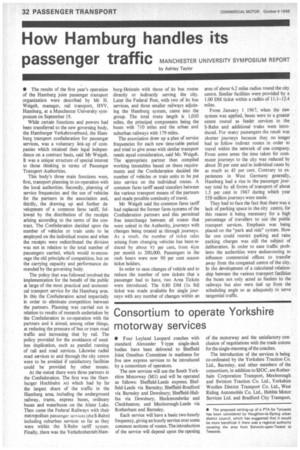How Hamburg handles its passenger traffic
Page 34

If you've noticed an error in this article please click here to report it so we can fix it.
MANCHESTER UNIVERSITY SYMPOSIUM REPORT by Ashley Taylor • The results of the first year's operation of the Hamburg joint passenger transport organization were described by Mr H. Weigelt, manager, rail transport, HVV, Hamburg, at a Manchester University symposium on September 19.
While certain functions and powers had been transferred to the new governing body, the Hamburger Verkehrsverbund, the Hamburg transport confederation for passenger services, was a voluntary link-up of companies which retained their legal independence on a contract basis, said Mr Weigelt. It was a unique structure of special interest to those thinking in terms of Passenger Transport Authorities.
This body's three main functions were, first, transport planning in co-operation with the local authorities. Secondly, planning of service frequencies and the use of vehicles for the partners in the association and, thirdly, the drawing up and further development of a common fares tariff, followed by the distribution of the receipts arising according to the terms of the contract. The Confederation decided upon the number of vehicles or train units to be employed on the individual routes and when the receipts were redistributed the division was not in relation to the total number of passengers carried, which would re-encourage the old principle of competition, but on the carrying capacity and performance demanded by the governing body.
The policy that was followed involved the implementation for the benefit of the public at large of the most practical and economical transport service for the Hamburg area. In this the Confederation acted impartially in order to eliminate competition between the partners. Planning was carried out in relation to results of research undertaken by the Confederation in co-operation with the partners and it aimed, among other things, at reducing the pressure of bus or tram road traffic and increasing that by rail. The policy provided for the avoidance of needless duplication, such as parallel running of rail and road services. Likewise radial road services to and through the city centre were to be avoided if satisfactory facilities could be provided by other means.
At the outset there were three partners in the Confederation. The first was the Hamburger Hochbahn AG which had by far the largest share of the traffic in the Hamburg area, including the underground railway, trams, express buses, ordinary buses and waterbuses on the Alster Lake. Then came the Federal Railways with their metropolitan passenger services (the S-Bahn) including suburban services so far as they were within the S-Bahn tariff system. Finally, there was the Verkehrsbetrieb Ham
burg-Holstein with those of its bus routes directly or indirectly serving the city. Later the Federal Post, with two of its bus services, and three smaller railways adjoining the Hamburg system, came into the group. The total route length is 1,010 miles, the principal components being the buses with 710 miles and the urban and suburban railways with 179 miles.
The association drew up a plan of service frequencies for each new time-table period and tried to give areas with similar transport needs equal consideration, said Mr. Weigelt. The appropriate partner then compiled working timetables based on these requirements and the Confederation decided the number of vehicles or train units to be put into service on the individual routes. A common fares tariff eased transfers between the various transport means of the partners and made possible continuity of travel.
Mr Weigelt said the common fares tariff had replaced the former fares systems of the Confederation partners and this permitted free interchange between all routes that were united in the Authority, journeys with changes being treated as through journeys. As a result. the number of ticket sales arising from changing vehicles has been reduced by about 95 per cent, from 4-4-rn per month to 200,000. Passengers in the rush hours were now 90 per cent season ticket holders.
In order to ease changes of vehicle and to reduce the number of new tickets that a passenger had to have, two Area Tickets were introduced. The 0.80 DM (Is 8d) ticket was made available for single journeys with any number of changes within an area of about 6.2 miles radius round the city centre. Similar facilities were provided by a 1.00 DM ticket within a radins of 11.1-12.4 miles.
From January 1 1967, when the new system was applied, buses were to a greater extent routed as feeder services to the S-Bahn and additional trains were introduced. For many passengers the result was shorter journeys because they no longer had to follow indirect routes in order to travel within the network of one company. From some areas the time taken for commuter journeys to the city was reduced by about 20 per cent and in individual cases by as much as 45 per cent. Contrary to experiences in West Germany generally, Hamburg had a rise in the passenger journey total by all forms of transport of about 1.5 per cent in 1967 during which year 558-million journeys were made.
They had to face the fact that there was a lack of parking space in the city centre, for this reason it being necessary for a high percentage of travellers to use the public transport services. Emphasis was being placed on the "park and ride" system. How far one could restrict parking and raise parking charges was still the subject of deliberation. In order to ease traffic problems the authorities were endeavouring to influence commercial offices to transfer away from the congested centre of the city. In the development of a calculated relationship between the various transport facilities the buses not only acted as feeders to the railways but also were tied up from the scheduling angle so as adequately to serve tangential traffic.












































































































